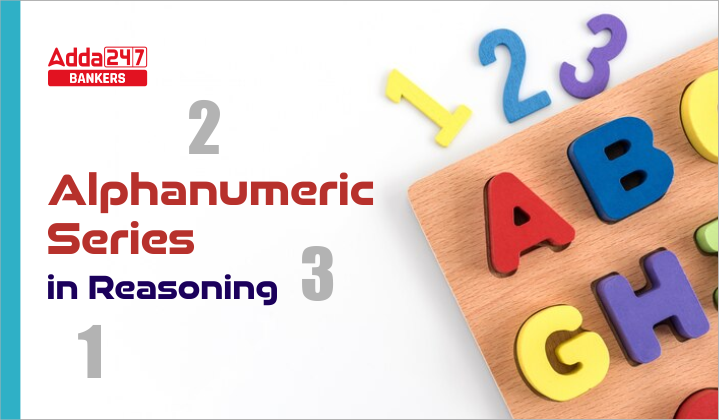The alphanumeric series is a crucial and frequently featured topic in the reasoning section of preliminary banking exams. It is among the easier topics within this section, with nearly 99% of candidates attempting these questions. Typically, a set of 5 questions is presented related to the alphanumeric series, and the key factor that sets candidates apart is their ability to solve these questions swiftly. In this article, we will provide you with valuable tricks and questions to master the art of reasoning in alphanumeric series.
Alphanumeric Series: Meaning
An alphanumeric series is a series that has a combination of both alphabets and numbers. To solve the alphanumeric series, candidates will be required to crack the logic behind the series.
Key Concepts to Remember
- Pattern Recognition: The fundamental skill in solving alphanumeric series questions.
- Alphabetic Sequence: Understanding the order of letters (A=1, B=2, etc.) is crucial.
- Numeric Progression: Recognizing arithmetic, geometric, or other numerical patterns.
- Combination Logic: Ability to identify multiple patterns working simultaneously.
- Forward and Backward Movement: Letters or numbers may progress in either direction.
- Mathematical Operations: Basic operations (addition, subtraction, multiplication, division) may be applied to numbers.
- Position-Based Logic: Using the position of letters or numbers to determine the pattern.
Types of Alphanumeric Series Questions
- Simple Alternating Series: In this type, letters and numbers alternate in a simple pattern. Example: A1, B2, C3, D4, ? Answer: E5 (The letters and numbers are advancing sequentially)
- Position-Based Series: Here, the position of letters in the alphabet or the place value of numbers is used to create the pattern. Example: A1, C3, E5, G7, ? Answer: I9 (Odd-positioned letters and odd numbers are used)
- Mathematical Operation Series: These involve simple mathematical operations on the numeric part of the series. Example: A2, C6, E12, G20, ? Answer: I30 (The numbers are multiplied by 3, 2, 5/3, and 3/2 respectively)
- Combination Series: These combine two or more patterns in the same series. Example: AB3, BC5, CD8, DE12, ? Answer: EF17 (Letters advance by one step each, numbers follow the Fibonacci sequence)
- Code-Based Series: These use coding techniques to create patterns. Example: A1Z, B2Y, C3X, D4W, ? Answer: E5V (Forward alphabet from the start, backward alphabet from the end, numbers increase)
Solving Techniques for Alphanumeric Series
The challenge is to identify the underlying rule and use it to find the next or missing element.
-
- Identify Components: Separate alphabets and numbers.
- Look for Patterns: Check for progressions in each component.
- Check Relationships: Look for connections between alphabetic and numeric parts.
- Consider Position Values: Remember A=1, B=2, etc.
- Try Mathematical Operations: Apply basic operations to numbers.
- Look for Coding Patterns: Consider simple coding techniques.
- Combine Multiple Rules: Complex series might use different rules for different parts.
Alphanumeric Series: Types With Tricks
Study the following letter-number-symbol sequence and answer the questions following it
P % R 1 5 H * M T E 3 B $ V N 4 K A 8 W I 6 2 G # U H 7 . J Q 9 L Y
Q.1 How many such vowels are there in the above arrangement each of which is immediately preceded by a consonant and immediately followed by a number
- Preceded- It means before
- Followed- It means After
In the above question you have to find this- Consonant Vowels Number
Common Mistake- Most of the candidates make this mistake in this kind of alphanumeric series is that they try to follow the sequence. But the correct method should be that you should find that character which is least in the series which is vowels here i.e. A, E, I, O, U. So the pair would be TE3, KA8, WI6
Ans. Three
Q.2 Which of the following is the seventh to the right of the twentieth from the right in the above arrangement?
Concept- So when in the question you find two times right then subtract the place values like here you would do 20 minus 7 and you will get 13 so now count 13th from the right end.
If you find the combination of left and right or right and left then add the place values. Now if you doubt from which direction you will start counting then you have to count from the second element like if there is a right-left combination then you have to count from the left.
Q.3 What should come in place of the question mark in the following series based on the above arrangement
5*T 3$N K8I ? .QL
Ans. 2 # H
When you have to find the missing element then try to crack the logic. In the above series, there is a pattern that there is a gap of one element between the two characters given above.
Q.4 Four of the following five are alike in a certain way concerning their position in the above arrangement. Which is the one that does not belong to that group
GUI, W64, 7J#, HMR, BVT
now when you find the word alike in such kind of series then you must be clear in your mind that you have to find the odd one out
Ans. W64
Q.5 If we remove all the vowels in the series then which of the following elements will be 7th from the right end
M 6 * I A 7 $ J # 5 4 B U 2 R Q D H L O @ P T E F
Concept- Some candidates make the mistake they writing a series after dropping the vowels and then counting the elements but you don’t have to follow this approach. Just imagine that vowels are not present in the series and then count the elements
Ans. D
Q6 If words are arranged according to the alphabetical series from left to right then which word is third from the left
YOM MJK UGJ IMX KQZ
a) UGJ
b) IMX
c) KQZ
d) MJK
e) None of these
Common mistake- Due to the pressure of the exam some candidates start arranging the letters in words in alphabetical order but we have to arrange words not letters. So the simple concept in these kinds of questions which candidates need to follow is the first word will be the one whose first letter comes before the others similarly you have to arrange all the words. In the above problem, the first word will be IMX.
Ans. MJK
Common Mistakes to Avoid
- Don’t Overcomplicate: Most exam questions have simple patterns.
- Avoid Assumptions: Verify patterns throughout the entire series.
- Don’t Ignore Any Component: Pay attention to both alphabets and numbers.
- Beware of Distractors: Some options might seem correct but don’t fit the entire pattern.




 GA Capsule for SBI Clerk Mains 2025, Dow...
GA Capsule for SBI Clerk Mains 2025, Dow...
 The Hindu Review October 2022: Download ...
The Hindu Review October 2022: Download ...
 IB ACIO 2025 Notification PDF Out for 37...
IB ACIO 2025 Notification PDF Out for 37...


